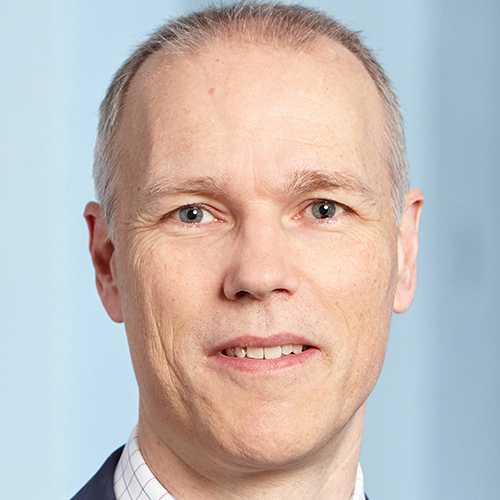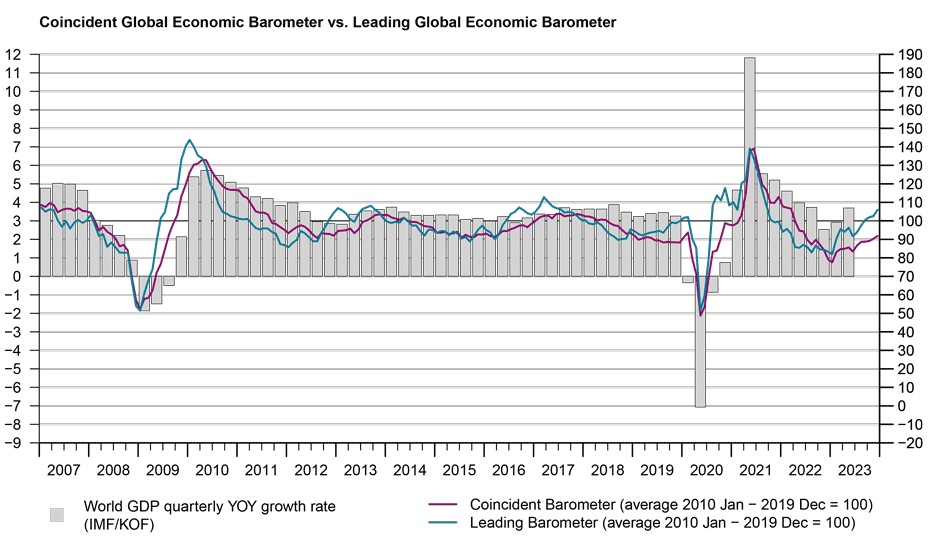Global Barometers on the rise for the sixth month in a row
The Global Barometers recorded their sixth consecutive increase, ending the year at a higher level than 12 months ago. The results signal that the recovery in global growth is continuing, albeit at a slow pace. The Coincident Barometer remains below 100 points, while the Leading Barometer has already established itself at a level above neutral.

The Coincident Global Economic Barometer rises 1.5 points in December to 91.8 points, while the Leading Barometer increases 3.3 points to 105.9 points, the highest level since September 2021 (108.5 pts.). In both cases, the Asia, Pacific & Africa region makes the largest contribution to the increase, while the other regions contribute much less. With the stronger rise in the Leading Barometer this month, the difference between the two Global Barometers is now 14.1 points, the largest since March 2021 (17.1 pts.)
“Despite the ongoing geopolitical tensions, the global economy is slowly emerging from its trough. The improvement in both the still below-average coincident barometer and the above-average leading indicator this month is due to data from Asia, the Pacific and Africa. As the gap between the two indicators has widened again, there is reason to be cautiously optimistic about the global economy. Although last year's frosty economic winter is still having an impact in many respects, the outlook has improved this time round” comments Prof Jan-Egbert Sturm, Director of KOF Swiss Economic Institute, the latest results.

“As the gap between the two indicators has widened again, there is reason to be cautiously optimistic about the global economy. Although last year's frosty economic winter is still having an impact in many respects, the outlook has improved this time round.”Jan-Egbert Sturm, Director of KOF Swiss Economic Institute
Coincident Barometer – regions and sectors
The increase in the Coincident indicator is mainly driven by the 1.3-point contribution of the Asia, Pacific & Africa region, while Europe contributes 0.2 points, and the Western Hemisphere remains constant. The regional indicators signal continued lukewarm global economic activity in gradual recovery, influenced by the various economic challenges faced by several countries. The graph below illustrates the contribution of each region to the deviation of the Coincident Barometer from the historical mean of 100 points.
All the Coincident sector indicators evolve positively in December, except for the Services sector, which decreased this month. The Trade (retail and wholesale) indicator continues to progress favourably since July of this year, drawing away from the other sectors and reaching the neutral level of 100 points.
Leading Barometer – regions and sectors
The Leading Global Barometer leads the world economic growth rate cycle by three to six months on average. In December, the positive regional contributions come from the three regions, with the Asia, Pacific & Africa region standing out with 2.1 points, followed by the Western Hemisphere and Europe, with 0.7 and 0.5 points, respectively. The levels of the indicators suggest a more widespread outlook of acceleration in the growth rate in the main regions, with the indicators for Europe and the Western Hemisphere fluctuating around the neutral mark of 100 points and the indicator for the Asia, Pacific & Africa region taking a more optimistic stance.
In December, all the Leading sector indicators increase except for Economy (aggregated business and consumer evaluations), which remained constant. The indicators for Services and Trade record their highest levels since the end of 2021, reflecting a positive outlook in relation to the coming months.

The Global Economic Barometers
The Global Economic Barometers are a system of indicators enabling timely analysis of global economic development. They represent a collaboration between the KOF Swiss Economic Institute of the ETH Zurich in Switzerland and Fundação Getulio Vargas (FGV), based in Rio de Janeiro, Brazil. The system consists of two composite indicators, the Coincident Barometer and the Leading Barometer. The Coincident Barometer reflects the current state of economic activity, while the Leading Barometer provides a cyclical signal roughly six months ahead of current economic developments.
The two Barometers comprise the results of economic tendency surveys conducted in more than 50 countries with the aim of achieving the broadest possible global coverage. The advantages of economic tendency surveys are that their results are usually readily available and are not substantially revised after first publication.
The Coincident Barometer includes more than 1,000 different time series, while the Leading Barometer consists of over 600 time series. Cross-correlation analysis is used to decide which individual time series are included in the barometers. This involves correlating the individual time series with a reference series. The reference series used is the year-on-year growth rate of global gross domestic product (GDP), where the individual national GDPs are aggregated at purchasing power parity to form global GDP. A time series is only included in a Barometer if it shows a sufficiently high correlation and a suitable synchronization or lead with the reference series. The time period used for this correlation analysis currently runs from January 2010 to December 2019.
The series of the two Barometers are revised each month at publication and are standardized to have a mean of 100 and a standard deviation of 10 for the 10-year period previous to the most recent observations.
The methodology is described in:
Klaus Abberger, Michael Graff, Aloisio Jr. Campelo, Anna Carolina Lemos Gouveia, Oliver Müller and Jan-Egbert Sturm (2020), The Global Economic Barometers: Composite indicators for the world economy. KOF Working Papers, vol. 471, Zurich: KOF Swiss Economic Institute, ETH Zurich, 2020.
Contact
KOF Konjunkturforschungsstelle
Leonhardstrasse 21
8092
Zürich
Switzerland
